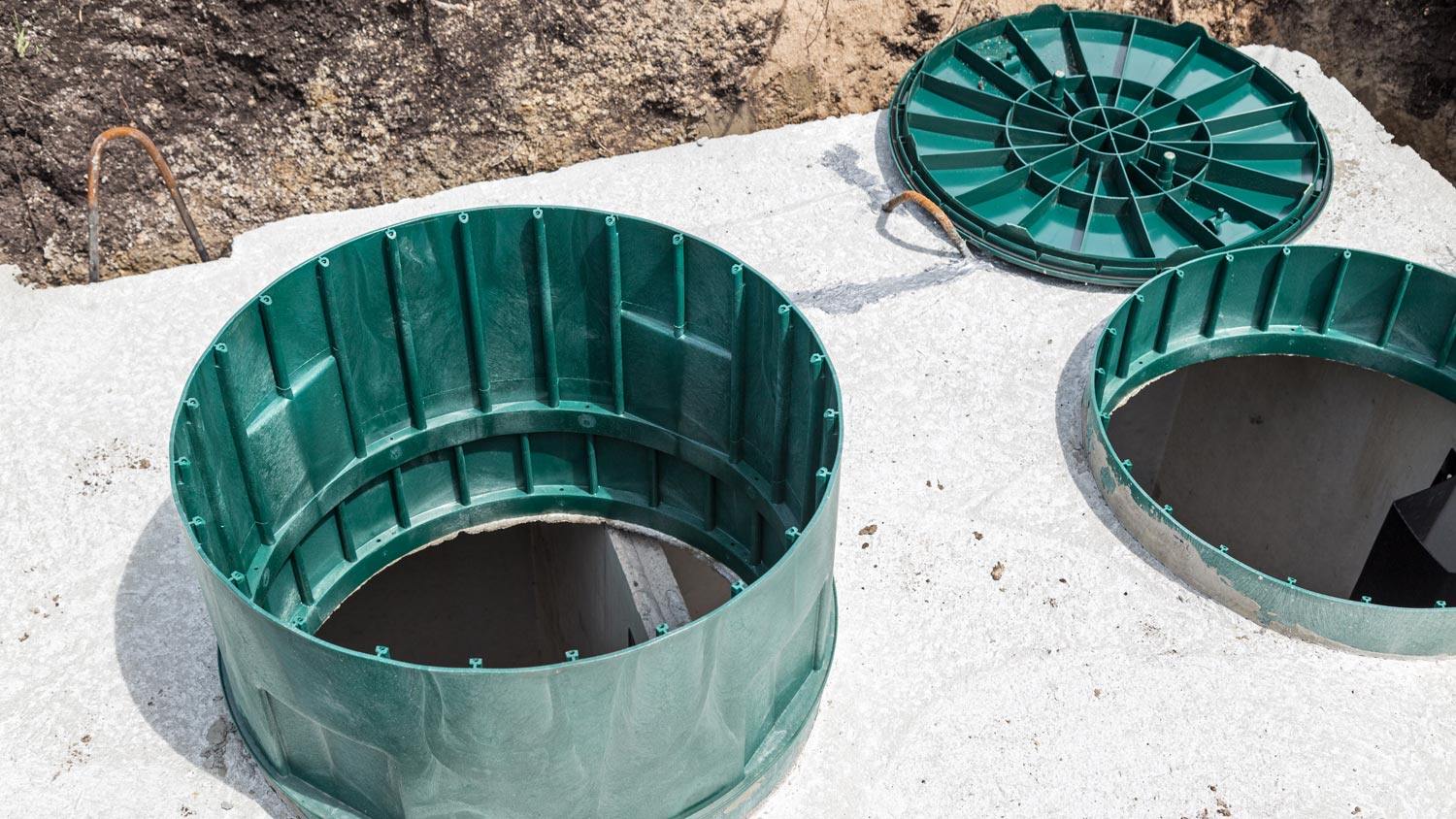
You should do a septic inspection once every one to three years to ensure you don’t have any issues. Learn about septic inspection costs before scheduling.
Oxygen-powered waste management magic


Aerobic septic systems use oxygen to treat waste, which is highly effective.
The three types of aerobic systems are fixed film, suspended growth, and trickling filter units.
The average aerobic septic system costs between $10,000 and $20,000.
Choosing the best type of septic system for your home isn't the most glamorous task, but it’s necessary to keep your plumbing running smoothly. You may have heard of an aerobic septic system, which uses oxygen to treat household waste. But there’s more to know about its pros, cons, and costs. Learn what an aerobic septic system is and whether it works for your property and budget.

An aerobic septic system is a type of wastewater treatment. This type uses oxygen to break down and treat waste and is more efficient than traditional anaerobic systems. Aerobic systems use an aerator to pump oxygen into the septic tank, encouraging the growth of bacteria that thrive in oxygen-rich environments. The bacteria is highly effective at breaking down organic matter, resulting in cleaner, treated effluent that's safely discharged.
The system consists of several components: a trash tank to catch solid waste, an aeration chamber where oxygen mixes with wastewater, and a clarifier that lets remaining solids settle before the treated water is released. Some systems also include a disinfection unit to purify the effluent further. This multi-step process allows aerobic systems to handle more wastewater and perform better in challenging soil conditions. They're great for smaller properties or areas with high water tables and suitable for septic tank landscaping.
The main difference between these types of septic systems is how they break down waste. While aerobic systems offer more efficient treatment, anaerobic systems are often a more budget-friendly, low-maintenance option for properties with enough space for proper drainage.
Unlike aerobic systems, anaerobic systems rely on bacteria that don’t need oxygen to break down waste, a slower process that leaves more solids in the effluent. These systems are simpler and less expensive to install but require larger drain fields to safely disperse partially treated wastewater into the soil for final filtration.
Homeowners can choose from three main types of aerobic septic systems. Aside from the types, you may have your choice of one-tank or three-tank systems. A one-tank system combines all treatment stages in a single compartment, while a three-tank system separates them into distinct tanks. If you're unsure which type of tank system to choose, your local septic tank company can help you decide.
A fixed film unit uses a solid, stationary surface, like a plastic or fiberglass media, for bacteria to grow on. Wastewater flows over this surface and the bacteria break down organic matter, treating the water before it moves to the next stage of the system.
The fixed surface is a stable environment and is reliable and less sensitive to fluctuations in water flow or waste levels. This type of unit is durable and boasts consistent performance. However, it requires occasional cleaning to prevent clogging.
In a suspended growth unit, bacteria float freely in the aeration chamber, mixing with wastewater as air is pumped in. The constant movement and oxygen supply help bacteria break down waste quickly.
This type of system is highly effective and can treat large volumes of wastewater. It requires regular maintenance to manage sludge buildup and keeps bacteria active. Because of its efficiency, a suspended growth unit is a good choice for households that produce a lot of wastewater.
A trickling filter unit passes wastewater through a bed of media, like gravel or plastic, where bacteria live and form a biofilm. Wastewater trickles down and the bacteria digest organic matter, purifying the water.
This system is simple and energy efficient because it relies on gravity rather than constant aeration. However, it can be less effective in handling high volumes of waste and may need regular media cleaning or replacement to prevent blockages and maintain treatment quality.
Aerobic septic systems can deliver higher efficiency than other types of septic systems, boasting benefits such as:
Faster Waste Breakdown: Oxygen boosts bacterial activity, speeding up waste decomposition.
Cleaner Effluent: Produces higher-quality treated water, suitable for surface irrigation.
Works in Poor Soil Conditions: Ideal for properties with high water tables or clay-heavy soil.
Smaller Drain Field Requirements: Needs less space than traditional systems, perfect for small lots.
Handles Higher Wastewater Volumes: Some types are more effective for larger households or properties with fluctuating water use.
Reduces Groundwater Contamination Risk: Thorough treatment lowers the chance of harmful pathogens reaching the soil or water supply.
While aerobic septic systems offer plenty of benefits, there are some downsides to consider:
Higher Initial Cost: More expensive to install than traditional anaerobic systems, ranging between $10,000 and $20,000. Even when you consider the cost to install a small septic garage, the price remains higher than anaerobic.
Ongoing Maintenance: Requires regular inspections, pump servicing, and component replacements. You'll also occasionally need to check if your septic tank is full.
Electricity Usage: Needs a constant power supply to run the aerator and other components.
Potential for Mechanical Failure: More moving parts mean a higher risk of breakdowns.
Noise and Odor Concerns: Aerators and air pumps can create noise, and malfunctions may cause unpleasant smells.
From average costs to expert advice, get all the answers you need to get your job done.

You should do a septic inspection once every one to three years to ensure you don’t have any issues. Learn about septic inspection costs before scheduling.

The average cost to connect to a public sewer line in Columbus, OH, depends on the linear footage, piping material, local regulations, and more.

Need to know what sewer line replacement costs in Los Angeles, CA? This guide will help you prepare to budget for sewer line replacement done by local contractors.

A sewage smell outdoors is not only gross, but it indicates a possible health hazard. Learn how to get rid of the septic smell outside and when to call a pro.

Some properties require an above-ground septic tank due to soil conditions or location. Learn all about above-ground septic tanks, pros, cons, and costs.

What is a septic tank distribution box, and how important is it? Learn about this critical component, its purpose, and how it functions in this guide.